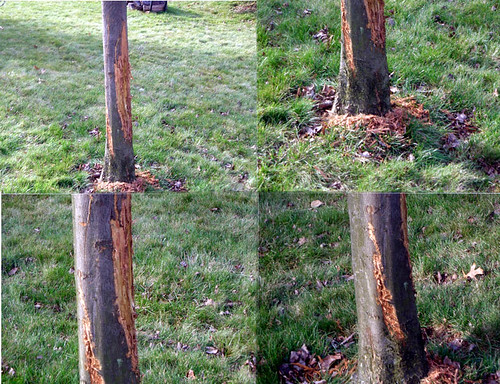
                                                  Photo by Worldman
Because male deer’, the bucks, antlers reach full growth in the fall, they want to get rid of the soft velvet that protected their antlers while they were growing. Early in the fall you may see a buck rubbing his antlers on the trunk of a tree or see evidence of the rubbing. Besides rubbing off the velvet on the antlers, later in the fall the deer can be marking his territory by rubbing trunks of trees. Bucks use glands in their foreheads to make scent markers on the trunks of trees. These rubbings are called “buck rubs.” Look for buck rubs on trees, usually one to two feet high off the ground, from September to December.
Though most trees are resilient to the buck rubs, it can be bad for the tree, especially if it is a young tree- losing bark on the tree trunk can kill a small tree. Damage that completely encircles the tree’s circumference is more deadly than damage up and down because the tree’s vascular system is just under the bark. Young trees have very thin bark that offers no protection from such damage.
You should surround the tree with a sturdy fence or barrier that can keep the male deer away from the tree trunk. A 6-foot-tall barrier of welded wire mesh, supported by 8-foot-tall rebar pounded into the ground at regular intervals around the circumference is one suggestion to keep bucks from rubbing on young trees. Another option is corrugated plastic drainpipe that has been slit along its length and placed around the trunk. While deer repellents can help prevent deer browsing, they are not very effective in controlling buck rubs.
Also, deer are hungry throughout the year and since much of their territory along with the plants they had always eaten has been built on, deer can damage home landscapes by feeding on your garden and landscape plants or scraping the soil around trees to further mark their territory.Â
You can reduce damage to the home landscape by growing plants which deer don’t usually eat; fencing the deer out- this has to be a fence at least 8 feet high, preferably 9 ft., with no area at the bottom of the fence where deer can crawl under (a friend was shocked to watch deer crawling UNDER the gap near the ground of her 8 ft fence);, or using repellents. All YEAR long, TheGardenLady sprays Liquid Fence and other repellents on all her landscape plants- even the plants the deer generally don’t eat.Â
It should be stressed that hungry deer, when they cannot find plants they like, will eat almost anything. Young, tender plants are generally more likely to be damaged than older, tougher plants. Deer are smart. You cannot outsmart deer by mixing plants deer prefer among those they dislike. They’ll trample those plants they dislike to get to those they prefer.
Â
If you see deer in the fall, keep your distance, do not get near those males. Males become very aggressive during their mating season and can attack. Those antlers on the muscular necks can do serious damage if they charge a human. And deer can run up to 40 miles an hour.
Â
A warning about Lyme disease. The Lyme tick has been seen on the bellies of deer all year long- even in the winter. So dress appropriately if you are in your garden or in other people’s property, meadows or woodland even in the winter.
Â
NJ has issued the following deer advisory for motorists. TheGardenLady believes that everyone who lives in areas where there are large numbers of deer should be warned.
Â
MOTORISTS ADVISED TO BE ALERT FOR DEER DURING AUTUMN
New Jersey has issued this deer advisory. TheGardenLady believes that everyone who lives in areas where there are large numbers of deer should be warned.
(08/48) TRENTON – Department of Environmental Protection Commissioner Lisa P. Jackson today urged motorists to drive carefully during autumn when New Jersey’s deer are particularly active and likely to be darting into roadways.
“Autumn is breeding season for white-tailed deer, and they are on the move,” Commissioner Jackson said. “Deer can be seen crossing roadways at any time of day, but typically are most active at dawn and dusk. Motorists can minimize the risk of accidents with deer by being alert and slowing down.”
The DEP encourages motorists to take the following precautions:
- Drive with caution when traveling through areas known to have large deer populations, particularly along sections of roadways posted as deer crossings.
- Slow down when you see deer on the roadside, and be alert for sudden movement. Remember that deer move in groups, so if you see one deer crossing the road, others might follo
- Use high beams after dark when there is no oncoming traffic. High beams illuminate the eyes of deer on or near a roadway, giving motorists more time to react.
- Always wear a seat belt as required by state law, and drive at a safe speed for road and weather conditions.
- Do not swerve if it appears you are going to hit a deer. Brake firmly, and stay in your lane. Motorists who swerve to avoid deer increase the likelihood of colliding with oncoming traffic or roadside obstacles.
- Keep in mind that deer are unpredictable. They may stop in the middle of the road while crossing or turn around and return to the roadside. If a deer remains in the road, do not try to go around it. Stop and wait until the road is clear.
- Report any deer-vehicle collisions to a local law enforcement agency immediately.
For more information about deer in New Jersey, visit the DEP’s Division of Fish and Wildlife Web site at www.njfishandwildlife.com.
